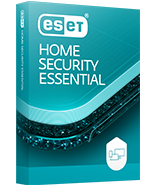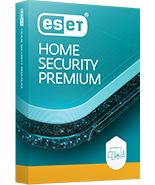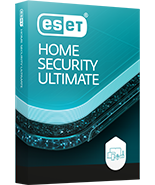Holiday Savings: Save 30% now
SAVE 15% OFF
For Business
Proactive cybersecurity for all business sizes and enterprise organizations.
Renew, enlarge, upgrade and more
099.9%
Eliminate risks
99.9% Malware protection rate against infection by malicious files. Minimize risk of data breach or cyber-attacks.
0100%
Software integrity
Resistance against most prevalent attacks.
005X
Lighter on system
With a lighter system footprint, your employees can use their PCs more smoothly while carrying out their daily task.
“A complex IT security solution must work properly and yet be easy to use. ESET masters this balance in an exemplary manner.„
Stefan Pistorius
EDP and Administration Manager Pharmaceuticals
OUR TOP-SELLERS
For home
FOR HOME
Antivirus, worry-free payments, and online privacy protection including anti-phishing and Wi-Fi protection.
- Real-time antivirus protection Our security shields you from more than just viruses, protecting against malware, ransomware, spyware, phishing, and more.
Available also for mac.OS - Safe banking and browsing Bank, shop, and connect with ease. Our secured browser mode boosts your privacy and helps avoid phishing scams.
- Seamless device performance Enjoy fast scans without interruption. Our Small System Footprint saves bandwidth and extends the life of your hardware—great for gaming and entertainment!
- Smart home and smartphone protection Protect everything from PCs, laptops, and smartphones to smart TVs and IoT devices. Lock and track missing devices, secure access to your webcam, and monitor microphone activity for enhanced privacy and control.
- Firewall, Wi-Fi and network shield Filter unwanted content, secure access to your network, and test your home router and smart devices for vulnerabilities.
- AI-powered threat detection Uses advanced artificial intelligence to proactively detect and block malware, ransomware, phishing, and other emerging threats in real time.
- Smarter protection for AI-powered computers ESET keeps your devices safe while leveraging their AI capabilities for faster, more efficient threat prevention.
- Encryption of sensitive data and photos Keep your files and USBs safe with military-grade encryption. Safely share your data with others.
- Elevated file and folder security Protect valuable data by allowing only trusted applications to modify your folders.
- Enhanced browser & privacy protection Easily manage website notifications and permissions, and remove metadata from images uploaded to your browser—details like capture time and location.
- Unlimited VPN Shield your connection and prevent unwanted tracking—anytime, anywhere. Enjoy unlimited bandwidth for endless access to your favorite online content.
Number of Available VPN Devices: Up to 25 devices → Ultimate plan (for more than 10 devices).
Up to 10 devices → Ultimate plan (for up to 10 devices).
Up to 5 devices → Premium plan (for more than 10 devices).
Up to 3 devices → Premium plan (for up to 10 devices) - VPN for Router Protects every device on your home network with one setup. Encrypts all internet traffic for safer browsing, streaming, and smart home use—no need to install apps on each device.
- Proactive identity protection Safeguard your digital identity and prevent identity theft. Monitor your credit score, scan the dark web for data leaks, and rely on 24/7 recovery services.
- Dark web scanning Scanning thousands of websites, including those on the Dark Web, blogs and other data sources to detect the illegal trading of your personal information.
- Credit report monitoring Instant online access to your credit reports and scores from 1 bureau so you can spot mistakes and fraudulent activity.
- Social media identity monitoring Monitor your Facebook, Twitter, YouTube, and Instagram accounts for inappropriate activity and posts that could be perceived as violent.
- Identity threat alerts Keep you updated on major data breaches, identity theft incidents, and new identity theft laws.
- SSN Tracking
- Lost wallet assistance Quickly cancel and replace credit, debit, and ATM cards if your wallet is lost or stolen. You’ll have peace of mind knowing you can stop fraudulent charges and order replacement credit cards by easily accessing your information online with Lost Wallet Assistance.
- Identity recovery + $1M insurance Restoration services from Certified Protection Experts, based in the U.S., who are available 24/7.
- Ransomware defense and recovery Keep your data untouchable: block zero-day ransomware, isolate threats, back up your data automatically, and restore everything in moments if encryption ever slips through.
Elevate your protection with unlimited VPN, encryption for sensitive files, and cutting-edge threat detection.
- Real-time antivirus protection Our security shields you from more than just viruses, protecting against malware, ransomware, spyware, phishing, and more.
Available also for macOS. - Safe banking and browsing Bank, shop, and connect with ease. Our secured browser mode boosts your privacy and helps avoid phishing scams.
- Seamless device performance Enjoy fast scans without interruption. Our Small System Footprint saves bandwidth and extends the life of your hardware—great for gaming and entertainment!
- Smart home and smartphone protection Protect everything from PCs, laptops, and smartphones to smart TVs and IoT devices. Lock and track missing devices, secure access to your webcam, and monitor microphone activity for enhanced privacy and control.
- Firewall, Wi-Fi and network shield Filter unwanted content, secure access to your network, and test your home router and smart devices for vulnerabilities.
- AI-powered threat detection Uses advanced artificial intelligence to proactively detect and block malware, ransomware, phishing, and other emerging threats in real time.
- Smarter protection for AI-powered computers ESET keeps your devices safe while leveraging their AI capabilities for faster, more efficient threat prevention.
- Encryption of sensitive data and photos Keep your files and USBs safe with military-grade encryption. Safely share your data with others.
- Elevated file and folder security Protect valuable data by allowing only trusted applications to modify your folders.
- Unlimited VPN Shield your connection and prevent unwanted tracking—anytime, anywhere. Enjoy unlimited bandwidth for endless access to your favorite online content.
Number of Available VPN Devices: Up to 25 devices → Ultimate plan (for more than 10 devices).
Up to 10 devices → Ultimate plan (for up to 10 devices).
Up to 5 devices → Premium plan (for more than 10 devices).
Up to 3 devices → Premium plan (for up to 10 devices)
- VPN for Router Protects every device on your home network with one setup. Encrypts all internet traffic for safer browsing, streaming, and smart home use—no need to install apps on each device.
- Enhanced browser & privacy protection Easily manage website notifications and permissions, and remove metadata from images uploaded to your browser—details like capture time and location.
- Proactive identity protection Safeguard your digital identity and prevent identity theft. Monitor your credit score, scan the dark web for data leaks, and rely on 24/7 recovery services.
- Dark web scanning Scanning thousands of websites, including those on the Dark Web, blogs and other data sources to detect the illegal trading of your personal information.
- Credit report monitoring Instant online access to your credit reports and scores from 1 bureau so you can spot mistakes and fraudulent activity.
- Social media identity monitoring Monitor your Facebook, Twitter, YouTube, and Instagram accounts for inappropriate activity and posts that could be perceived as violent.
- Identity threat alerts Keep you updated on major data breaches, identity theft incidents, and new identity theft laws.
- SSN Tracking
- Lost wallet assistance Quickly cancel and replace credit, debit, and ATM cards if your wallet is lost or stolen. You’ll have peace of mind knowing you can stop fraudulent charges and order replacement credit cards by easily accessing your information online with Lost Wallet Assistance.
- Identity recovery + $1M insurance Restoration services from Certified Protection Experts, based in the U.S., who are available 24/7.
- Ransomware defense and recovery Keep your data untouchable: block zero-day ransomware, isolate threats, back up your data automatically, and restore everything in moments if encryption ever slips through.
Top security with VPN, VPN for Router, Identity Protection & Ransomware Remediation.
- Real-time antivirus protection Our security shields you from more than just viruses, protecting against malware, ransomware, spyware, phishing, and more.
Available also for macOS. - Safe banking and browsing Bank, shop, and connect with ease. Our secured browser mode boosts your privacy and helps avoid phishing scams.
- Seamless device performance Enjoy fast scans without interruption. Our Small System Footprint saves bandwidth and extends the life of your hardware—great for gaming and entertainment!
- Smart home and smartphone protection Protect everything from PCs, laptops, and smartphones to smart TVs and IoT devices. Lock and track missing devices, secure access to your webcam, and monitor microphone activity for enhanced privacy and control.
- Firewall, Wi-Fi and network shield Filter unwanted content, secure access to your network, and test your home router and smart devices for vulnerabilities.
- AI-powered threat detection Uses advanced artificial intelligence to proactively detect and block malware, ransomware, phishing, and other emerging threats in real time.
- Smarter protection for AI-powered computers ESET keeps your devices safe while leveraging their AI capabilities for faster, more efficient threat prevention.
- Encryption of sensitive data and photos Keep your files and USBs safe with military-grade encryption. Safely share your data with others.
- Elevated file and folder security Protect valuable data by allowing only trusted applications to modify your folders.
- Unlimited VPN Shield your connection and prevent unwanted tracking—anytime, anywhere. Enjoy unlimited bandwidth for endless access to your favorite online content.
Number of Available VPN Devices: Up to 25 devices → Ultimate plan (for more than 10 devices).
Up to 10 devices → Ultimate plan (for up to 10 devices).
Up to 5 devices → Premium plan (for more than 10 devices).
Up to 3 devices → Premium plan (for up to 10 devices)
Available also for macOS. - VPN for Router Protects every device on your home network with one setup. Encrypts all internet traffic for safer browsing, streaming, and smart home use—no need to install apps on each device.
- Enhanced browser & privacy protection Easily manage website notifications and permissions, and remove metadata from images uploaded to your browser—details like capture time and location.
- Proactive identity protection Safeguard your digital identity and prevent identity theft. Monitor your credit score, scan the dark web for data leaks, and rely on 24/7 recovery services.
Available also for macOS.- Dark web scanning Scanning thousands of websites, including those on the Dark Web, blogs and other data sources to detect the illegal trading of your personal information.
- Credit report monitoring Instant online access to your credit reports and scores from 1 bureau so you can spot mistakes and fraudulent activity.
- Social media identity monitoring Monitor your Facebook, Twitter, YouTube, and Instagram accounts for inappropriate activity and posts that could be perceived as violent.
- Identity threat alerts Keep you updated on major data breaches, identity theft incidents, and new identity theft laws.
- SSN Tracking
- Lost wallet assistance Quickly cancel and replace credit, debit, and ATM cards if your wallet is lost or stolen. You’ll have peace of mind knowing you can stop fraudulent charges and order replacement credit cards by easily accessing your information online with Lost Wallet Assistance.
- Identity recovery + $1M insurance Restoration services from Certified Protection Experts, based in the U.S., who are available 24/7.
- Ransomware defense and recovery Keep your data untouchable: block zero-day ransomware, isolate threats, back up your data automatically, and restore everything in moments if encryption ever slips through.
For business
FOR BUSINESS
Modern multilayered endpoint protection featuring strong machine learning and easy-to-use management
- Console (cloud/on-prem) Unified cybersecurity platform interface providing superior network visibility and control. Available as cloud or on-prem deployment.
- Modern Endpoint Protection with Next-gen Antivirus Advanced multilayered protection for computers and smartphones powered by unique ESET LiveSense technology.
- Server Security Real-time protection for your company’s data passing through all general servers.
- Full Disk Encryption Robust encryption solution for system disks, partitions or entire devices to achieve legal compliance.
- Advanced Threat Defense Proactive cloud-based prevention against ransomware or never-before-seen threat types with autonomous remediation capabilities.
- Extended Detection and Response Additional platform capability to proactively detect threats, effectively identify anomalous behavior in the network and realize timely remediation, preventing breaches and business disruption.
ESET Inspect, the XDR-enabling cloud-based tool, provides outstanding threat and system visibility, allowing risk managers and security professionals to perform fast and in-depth root cause analysis and immediately respond to incidents. - MDR Service 24/7 managed detection and response service combining AI and human expertise to achieve unmatched threat detection and rapid incident response.
Vulnerability & Patch Management Actively track & fix vulnerabilities in operating systems and applications across all endpoints.
Available as on demand upgrade providing additional protection layer. Click on the plus sign and contact a sales person to receive an offering tailored to your individual needs. No commitment.
Mobile Threat Defense Robust security for all Android and iOS mobile devices within the organization. Equip your mobile fleet with Antimalware, Anti-Theft and MDM capabilities.
Available as on demand upgrade providing additional protection layer. Click on the plus sign and contact a sales person to receive an offering tailored to your individual needs. No commitment.
Mail Server Security An additional layer of security, protecting Exchange and IBM email servers from threats entering the network on top of the standard endpoint and file server protection.
Features advanced anti-phishing, anti-malware, and anti-spam combined with cloud-powered proactive threat defense. Provides you with robust quarantine management and rule definition/filtering system.
Prevents ransomware and other email-borne attacks without compromising email's speed.
Available as on demand upgrade providing additional protection layer. Click on the plus sign and contact a sales person to receive an offering tailored to your individual needs. No commitment.
Cloud App Protection Advanced protection for Microsoft 365 and Google Workspace apps, with additional proactive threat defense.
Available as on demand upgrade providing additional protection layer. Click on the plus sign and contact a sales person to receive an offering tailored to your individual needs. No commitment.
Multi-Factor Authentication Single-tap, mobile-based multi-factor authentication that protects organizations from weak passwords and unauthorized access.
Available as on demand upgrade providing additional protection layer. Click on the plus sign and contact a sales person to receive an offering tailored to your individual needs. No commitment.
Premium Support Essential Prioritized, accelerated and guaranteed support from experts.
Best-in-class endpoint protection against ransomware & zero-day threats, backed by powerful data security
- Console (cloud/on-prem) Unified cybersecurity platform interface providing superior network visibility and control. Available as cloud or on-prem deployment.
- Modern Endpoint Protection with Next-gen Antivirus Advanced multilayered protection for computers and smartphones powered by unique ESET LiveSense technology.
- Server Security Real-time protection for your company’s data passing through all general servers.
- Mobile Threat Defense Robust security for all Android and iOS mobile devices within the organization. Equip your mobile fleet with Antimalware, Anti-Theft and MDM capabilities.
- Full Disk Encryption Robust encryption solution for system disks, partitions or entire devices to achieve legal compliance.
- Advanced Threat Defense Proactive cloud-based prevention against ransomware or never-before-seen threat types with autonomous remediation capabilities.
Available as on demand upgrade providing additional protection layer. Click on the plus sign and contact a sales person to receive an offering tailored to your individual needs. No commitment.
Vulnerability & Patch Management Actively track & fix vulnerabilities in operating systems and applications across all endpoints.
Available as on demand upgrade providing additional protection layer. Click on the plus sign and contact a sales person to receive an offering tailored to your individual needs. No commitment.
Cloud App Protection Advanced protection for Microsoft 365 and Google Workspace apps, with additional proactive threat defense.
Available as on demand upgrade providing additional protection layer. Click on the plus sign and contact a sales person to receive an offering tailored to your individual needs. No commitment.
Mail Server Security An additional layer of security, protecting Exchange and IBM email servers from threats entering the network on top of the standard endpoint and file server protection.
Features advanced anti-phishing, anti-malware, and anti-spam combined with cloud-powered proactive threat defense. Provides you with robust quarantine management and rule definition/filtering system.
Prevents ransomware and other email-borne attacks without compromising email's speed.
Unlock a higher protection tier with the added advantage of EDR included. Click on the plus sign and reach out to our dedicated sales team to explore a tailored offering that meets your unique requirements. No commitment.
Starting at 25 devices.
Extended Detection and Response Additional platform capability to proactively detect threats, effectively identify anomalous behavior in the network and realize timely remediation, preventing breaches and business disruption.
ESET Inspect, the XDR-enabling cloud-based tool, provides outstanding threat and system visibility, allowing risk managers and security professionals to perform fast and in-depth root cause analysis and immediately respond to incidents.
Available as on demand upgrade providing additional protection layer. Click on the plus sign and contact a sales person to receive an offering tailored to your individual needs. No commitment.
MDR Service 24/7 managed detection and response service combining AI and human expertise to achieve unmatched threat detection and rapid incident response.
Available as on demand upgrade providing additional protection layer. Click on the plus sign and contact a sales person to receive an offering tailored to your individual needs. No commitment.
Multi-Factor Authentication Single-tap, mobile-based multi-factor authentication that protects organizations from weak passwords and unauthorized access.
Available as on demand upgrade providing additional protection layer. Click on the plus sign and contact a sales person to receive an offering tailored to your individual needs. No commitment.
Premium Support Essential Prioritized, accelerated and guaranteed support from experts.
Complete, multilayered protection for endpoints, cloud applications and email, the number one threat vector
- Console (cloud/on-prem) Unified cybersecurity platform interface providing superior network visibility and control. Available as cloud or on-prem deployment.
- Modern Endpoint Protection with Next-gen Antivirus Advanced multilayered protection for computers and smartphones powered by unique ESET LiveSense technology.
- Server Security Real-time protection for your company’s data passing through all general servers.
- Mobile Threat Defense Robust security for all Android and iOS mobile devices within the organization. Equip your mobile fleet with Antimalware, Anti-Theft and MDM capabilities.
- Full Disk Encryption Robust encryption solution for system disks, partitions or entire devices to achieve legal compliance.
- Advanced Threat Defense Proactive cloud-based prevention against ransomware or never-before-seen threat types with autonomous remediation capabilities.
- Vulnerability & Patch Management Actively track & fix vulnerabilities in operating systems and applications across all endpoints.
- Mail Server Security An additional layer of security, protecting Exchange and IBM email servers from threats entering the network on top of the standard endpoint and file server protection.
Features advanced anti-phishing, anti-malware, and anti-spam combined with cloud-powered proactive threat defense. Provides you with robust quarantine management and rule definition/filtering system.
Prevents ransomware and other email-borne attacks without compromising email's speed. - Cloud App Protection Advanced protection for Microsoft 365 and Google Workspace apps, with additional proactive threat defense.
- Extended Detection and Response Additional platform capability to proactively detect threats, effectively identify anomalous behavior in the network and realize timely remediation, preventing breaches and business disruption.
ESET Inspect, the XDR-enabling cloud-based tool, provides outstanding threat and system visibility, allowing risk managers and security professionals to perform fast and in-depth root cause analysis and immediately respond to incidents. - MDR Service 24/7 managed detection and response service combining AI and human expertise to achieve unmatched threat detection and rapid incident response.
Available as on demand upgrade providing additional protection layer. Click on the plus sign and contact a sales person to receive an offering tailored to your individual needs. No commitment.
Multi-Factor Authentication Single-tap, mobile-based multi-factor authentication that protects organizations from weak passwords and unauthorized access.
Available as on demand upgrade providing additional protection layer. Click on the plus sign and contact a sales person to receive an offering tailored to your individual needs. No commitment.
Premium Support Essential Prioritized, accelerated and guaranteed support from experts.
Price valid for the first term only. The price displayed is valid for the first term. If a savings amount is shown, it describes the difference between the first term’s price and the official list price. While price is subject to change, we will always send you a notification email in advance.
Consistently validated by customers worldwide
Research Excellence
ESET researchers are among the most active contributors to MITRE ATT&CK®, a global knowledge base of adversary tactics. They have discovered previously unknown cyberespionage groups like Sandworm, MoustachedBouncer, Turla and more.
Technology Leader
Continuous innovation has allowed ESET to develop a multitude of unique, proprietary, cloud-powered, and multi-layered protection technologies that work together as ESET LiveSense.
Customer service
ESET, a global leader in cybersecurity, is proud to announce that the company has won a 2023 SC Award in the Excellence Award category for Best Customer Service
MULTI-LAYERED PROTECTION
16 layers safeguard 1+ billion internet users worldwide
LIGHT ON RESOURCES
Top performer for 11 years in AV-Comparatives testing
EASY TO USE
Verified by consumer reviews on Trustpilot
AWARD-WINNING
100+ consecutive VB100 awards
SUPPORT IN YOUR LANGUAGE
700+ customer care experts
SOCIALLY RESPONSIBLE
Benefiting society for more than 30 years
ESET RESPONDS TO THE UKRAINIAN CRISIS AND RELATED CYBERATTACKS.
We are offering a helping hand on several fronts.
Find out more
Existing customer?
Find everything you need at our customer portal
Update your subscription and
eStore account information.
Renew, upgrade or add
devices to your ESET license.



